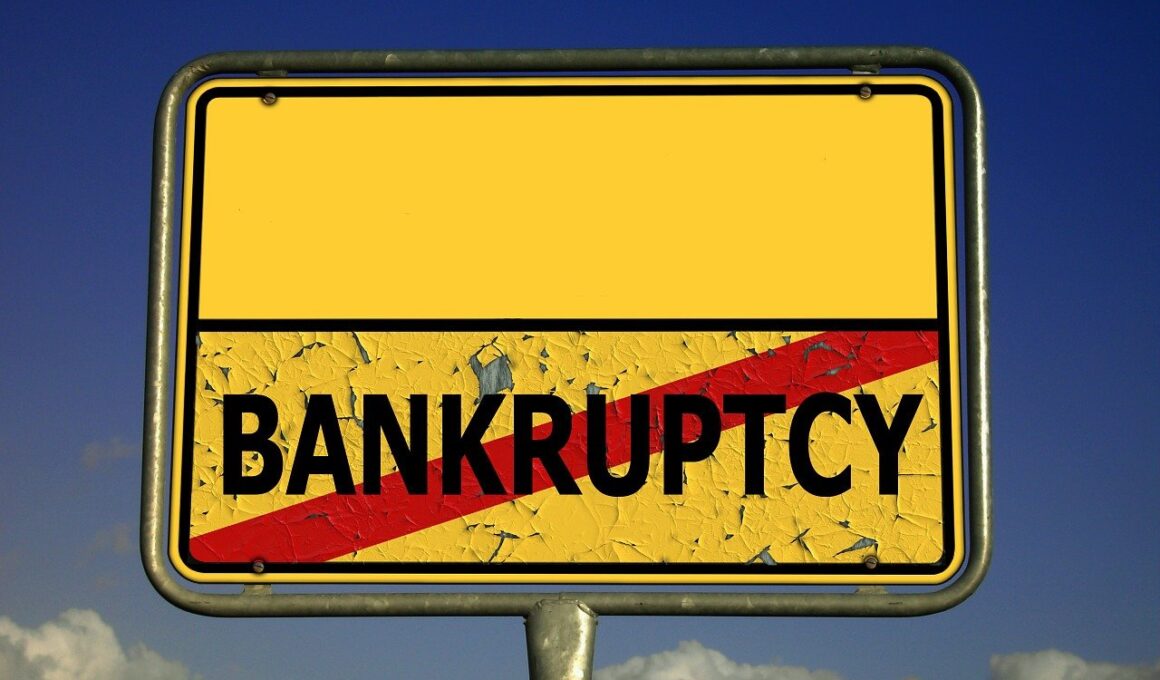Bankruptcy Causes and Prevention: Identifying Risk Factors
Bankruptcy is a significant financial crisis that can have lasting effects on individuals and businesses. Understanding the causes of bankruptcy is crucial for better prevention among potential risk groups. Common causes include reducing income, overwhelming medical expenses, job loss, and excessive debt accumulation. These financial pressures can lead to a cascade of stress and poor decision-making. In addition, unexpected life events can drastically alter one’s financial standing, pushing them toward bankruptcy. Moreover, economic downturns can increase unemployment rates, leaving many struggling to meet essential expenses. Financial mismanagement, such as overspending or relying too heavily on credit, can also lead to insolvency. These factors all highlight the importance of financial literacy and planning ahead to mitigate risks. Risk factors can vary significantly depending on individual circumstances, such as income levels, existing debts, and overall economic conditions. Therefore, understanding one’s risk factors is essential to develop strategies aimed at minimizing bankruptcy risks. By recognizing these contributing elements, individuals and businesses can take proactive measures toward financial stability and safeguarding their futures.
Identifying Risk Factors
Identifying specific risk factors that can lead to bankruptcy is an essential step in prevention efforts. One primary risk factor is credit card debt, which can accumulate due to a lack of financial discipline and impulse spending. To mitigate this risk, individuals must maintain a balanced budget that prioritizes paying off debts over unnecessary expenditures. Another significant risk factor is significant medical expenses, as health crises can drain savings and lead to insurmountable bills. Preventive measures include obtaining adequate health insurance coverage and creating an emergency fund for unexpected medical expenses. Another common contributing factor is loss of employment, which directly reduces income sources. Keeping an up-to-date resume and networking regularly can help prevent job loss from triggering bankruptcy. Additionally, poor financial planning and budgeting often exacerbate these risks. For those struggling with budgeting, resources such as financial advisors or online tools can provide valuable assistance. By recognizing and addressing these specific risks proactively, individuals can take proactive decisions that foster improved financial standings and aim to avoid the pitfalls associated with bankruptcy.
In addition to personal financial habits, external factors such as economic conditions play a significant role in bankruptcy risk. Economic downturns can lead to increased unemployment rates and reduced spending, ultimately resulting in financial hardship for many individuals. Analyzing local and national economic indicators, available jobs, and industry trends can help predict potential risks. Furthermore, geographical location influences bankruptcy rates; certain areas may face economic challenges that disproportionately affect residents. This geographic factor highlights the importance of staying connected to one’s economic landscape, as fluctuations can cause shifts in personal financial situations. Businesses, too, must remain vigilant about market trends to avoid bankruptcy-triggering conditions. Those who plan proactively by diversifying income sources or seeking professional advice can better prepare for such scenarios. In addition to economic factors, lifestyle choices and values also contribute significantly to financial well-being. Evaluating personal spending habits can lead to significant insights into potential problems. Taking these factors into account allows individuals to identify possible challenges and create tailored strategies that reduce the likelihood of facing bankruptcy.
Prevention Strategies
Prevention strategies play a vital role in reducing the risks of bankruptcy. One essential approach is to establish a realistic and detailed budget to track income and expenses. This practice enables individuals to see where their money is going and identify areas for potential savings. Moreover, an emergency fund is crucial; setting aside a portion of income each month can serve as a financial buffer during crises. Financial literacy education is another preventive measure, as it empowers individuals with knowledge on debt management, investment opportunities, and understanding credit. Seeking assistance from financial advisors or attending workshops can provide valuable insights into sound financial practices. Additionally, having appropriate insurance coverage can protect against unforeseen circumstances that could lead to financial instability. Managing debt effectively is vital to bankruptcy prevention, so strategies such as debt consolidation or prioritization of high-interest debts are recommended. Lastly, adopting a lifestyle that focuses on efficient spending rather than compulsive purchasing promotes financial health. By incorporating these strategies, individuals can significantly reduce their risk of bankruptcy and work towards achieving long-term financial stability.
Furthermore, addressing underlying habits is essential in bankruptcy prevention. Building a positive mindset towards saving and financial planning fosters resilience against potential financial crises. Seeking advice from trusted sources, whether financial experts or support groups, can often illuminate helpful strategies or insights that individuals may have overlooked. Creating accountability, such as involving friends or family in financial discussions, can reinforce responsible financial behavior. Engaging with technology plays a pivotal role as well, with numerous apps available to help track expenses, manage budgets, and set financial goals. These tools make it easier to stay on course and evaluate spending habits regularly. Additionally, learning from past financial mistakes is vital; reviewing previous budgets and understanding what went wrong can provide insights for better future decision-making. Individuals should also consider social influences when it comes to spending and lifestyle choices, as societal pressures can lead to unnecessary debt accumulation. The ultimate goal is to develop a comprehensive approach that addresses various aspects of financial health. By addressing these behaviors and creating a supportive financial environment, bankruptcy risks can be significantly mitigated.
Conclusion: Planning for the Future
In conclusion, prioritizing bankruptcy prevention requires a multifaceted approach that encompasses individual habits and external influences. Identifying risk factors is the cornerstone of these efforts, allowing individuals to understand their vulnerabilities. It is imperative for consumers to recognize their financial habits, understand the complexities of their individual situations, and make informed decisions. Regular financial assessments can help to identify potential warning signs long before they escalate into dire situations. It is essential to integrate the insights gained from this understanding into practices that promote financial health. By creating a solid financial foundation, people can build resilience against unexpected setbacks and manage risks effectively. This proactive mindset, characterized by strategic planning and informed decision-making, not only decreases the likelihood of bankruptcy but enhances overall financial stability. Ultimately, sustained success in preventing bankruptcy involves taking control of one’s finances and continuously adapting strategies to meet evolving circumstances. As economic landscapes change and individual needs shift, having a framework to navigate these challenges is crucial. With the right measures in place, individuals and businesses can secure a prosperous financial future.
In summary, addressing the causes and prevention of bankruptcy begins with awareness and education. Understanding specific risk factors helps identify areas requiring attention, while effective strategies lay the groundwork for sound financial practices. By fostering financial literacy, individuals can develop skills that enhance their decision-making processes, leading to better outcomes. The integration of preventative measures such as budgeting, emergency savings, and debt management encourages resilience against potential challenges. Furthermore, adopting a proactive mindset and maintaining awareness of external economic factors empowers individuals to adapt as needed, providing the flexibility to manage risks successfully. Engaging with trusted financial resources or seeking professional advice can significantly enhance one’s grasp of complex financial landscapes. By implementing the strategies discussed throughout this article, individuals can prepare for unanticipated circumstances and strive towards improved financial health. The path to achieving long-term financial success is a continuous journey, necessitating ongoing reflection and adaptability. These collective efforts contribute not only to preventing bankruptcy but also to nurturing financial well-being, security, and confidence in one’s financial choices.


